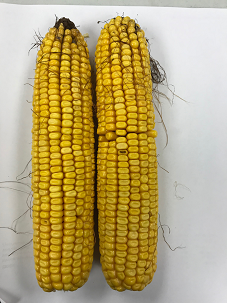9.1.18 Agronomy Update
Sep 19, 2018

9.1.18 Agronomy Update
by Brian Weller, LeadThe temperatures during the week ranged from the upper 40°F’s for lows, to the low 80°F’s for highs. We did receive spotty rain showers during the week accompanied by hail in some areas. There was some corn silage that was harvested in between rain events, yields that I have heard were average to slightly above average.
Corn plant development is in the dent stage for almost all planting dates. Corn planted in early May is at 70-80% Milk line as shown below and on the right.


| Planting Date | GDU'S | Growth Stage | Growth Stage |
| 28-Apr | 2329.50 | Late Dent | R5 |
| 5-May | 2245.50 | Dent | R5 |
| 13-May | 2174.50 | Dent | R5 |
| 19-May | 2083.50 | Dent | R5 |
| 26-May | 1968.50 | Dough/Early Dent | R4-R5 |
We accumulated 126 Growing Degree Units (GDU) during the week which is 18 GDU’s per day or .14 GDU’s less than the 30-year average.
| Dates | 2018 GDU Average/Day | 30 Year GDU Average/Day | Difference/Day |
| August 26-September 1 | 18.00 | 18.14 | -0.14 |
| August 1-31 | 18.87 | 18.84 | 0.03 |
| Dates | 2018 GDU | 30 Year GDU Average | Difference |
| August 26-September 1 | 126.0 | 127.0 | -1.00 |
| August 1-31 | 585.0 | 584.0 | 1.00 |
For the month of August, we collected 585 GDU’s which is 1 GDU more than the 30-year average.
In August we have experienced days with less sunlight, these days for the most part were warm with many days being partly cloudy or hazy due to wild fires. We need temperatures between 50-86°F for corn to accumulate GDU’s. If plants are not actively photosynthesizing or not enough, they will pull starch from other portions of the plant stalks, leaves etc., which will reduce yield but also will affect late season standability and harvestability. It is my belief that on cloudy days with less than 50% sunshine, (clouds or haze) we can lose .25-.5 bushels/day. From August 1 to August 31 we will lose 81 minutes of daylight, or just over 2.6 minutes per day.
It normally takes 55-65 days from the Tassel/Silking date (R1) to Physiological Maturity or Black Layer (R6). The anticipated date of Black Layer by planting date is listed in the table below. This is calculated with the belief that a 100-103-day hybrid was planted, and that we will receive “normal” temperatures and GDU accumulation between now and R6.
| Planting Date | GDU'S | GDU'S to R6 | Days to R6 | Date of R6 |
| 12-Apr | 2329.5 | 145.5 | 8 | 8-Sep |
| 24-Apr | 2245.5 | 229.5 | 12 | 13-Sep |
| 5-May | 2174.5 | 300.5 | 16 | 16-Sep |
| 12-May | 2083.5 | 391.5 | 21 | 21-Sep |
| 2-Jun | 1968.5 | 506.5 | 27 | 27-Sep |
In walking corn fields, the nitrogen deficiencies that we have seen, coupled with compaction and moisture issues have pushed plants to rob nutrients from the leaves and stalks to fill the kernels. This reallocation of nutrients will cause more standability and subsequent harvestability issues, the later into harvest we get. It is strongly advised that you contact our Central Farm Service or Central Advantage representative to develop a harvest order or plan to maximize yield protection.
Soybean plant development is from R6 (Full Seed-Pod containing a green seed that fills the pod cavity at one of the four uppermost nodes on the main stem, with a fully developed leaf.) We do have some early planted early maturing soybeans that are pushing R7 (Beginning Maturity-One normal pod on the main stem that has reached its mature pod color, brown or tan) and is starting to lose more leaves compared to its later maturing neighbor, for Soybeans planted in late April or early May. Soybeans that were planted in late June to early July are at the R5 (Beginning Seed-Seed is 1/8’ long in the pod at one of the four uppermost nodes on the main stem).
As an Agronomist I never seem to tire watching and comparing maturity on soybeans, how they react to the rainfall, the environment, and how leaves come off. The photo below and on the left compares a 1.2 maturity soybean and a 1.4 maturity soybean on September 1. The photo below and on the right shows the same soybeans on August 25, a lot can happen in a week.


The take home from these photos is, soybean harvest will be upon us sooner than what we think.
Insurance Reminders:
- Contact your Crop Insurance Agent if you are chopping corn for sileage, this is so your silage tons can be converted into bushel equivalents.
- Also, if you have grain left in the bin prior to harvest, contact your agent to have the bin measured.
Central Farm Service Website: Central Farm Service Agronomy Notes and Updates can be found on our website www.CFSCOOP.com at the bottom of the home page. Past Agronomy Notes and Updates can be found under the News tab and Agronomy News.
We are also on Facebook and Twitter with links to both on the Central Farms Service website www.CFSCOOP.com
Central Farm Service Agronomy Videos have been posted on Twitter and Facebook, these video updates will be appearing from time to time.
If you have been receiving our Agronomy Notes of the week via mail and would like them emailed to you, contact your local Central Farm Service Agronomist or myself at bweller@cfscoop.com Use the same procedure if you would like to be taken off this list.

